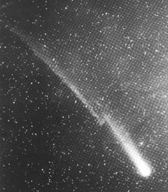太陽光の圧力ではこのようなイオンテイルの動きを説明することはできません。
1943年、ドイツのCuno Hoffmeister、さらにその後にはLudwig Biermannが
太陽は太陽光の他に "solar corpuscular radiation(太陽の球状の放射)"
という粒子の流れを放出していて、それが彗星の尾のイオンを
押すのではないかと提案しました。粒子の速度の変化で彗星の尾の加速を
説明できますし、彗星の尾が太陽の正反対には伸びていないのは
粒子の流れの速度は彗星の速度の何倍も速いわけではないためと
考えることができます。
Sunlight pressure cannot explain such behavior, but in 1943 Cuno
Hoffmeister in Germany, and later Ludwig Biermann, proposed that apart
from sunlight, the Sun also emitted a steady stream of particles, a
"solar corpuscular radiation" which pushed the ions. Variations in
the speed of the particles would explain the accelerations, and the tail
did not point straight away from the Sun because the flow velocity of the
particles was not too many times larger than the velocity of the comet
itself.
パーカーの理論 Parker's Theory
この"粒子の放射"が存在する理由は、まったくわかっていませんでした。
それが解明されたのは、シカゴ大学のEugene Parkerが1958年に
コロナの平衡構造を求めようとした時です。太陽から非常に遠いところでは
コロナは薄くなって圧力も密度も0になると考えられていましたが、
Parkerは、熱伝導のためにそういった静水圧平衡は成り立たず、
コロナの最上部がBiermannの提唱した粒子流と同じような速度で
太陽から流れ去っていることを発見しました。この流れは
"solar wind 太陽風(たいようふう)"と名づけられ、
その存在は、のちに探査機の搭載機器によって確かめられました。
No one gave a good reason why this "particle
radiation" should exist, until Eugene Parker of the University of Chicago
in 1958 tried to derive the equilibrium structure of the corona. One
expects the corona at great distances to dwindle away to zero pressure and
density, but Parker found that the conduction of heat interfered with such
an equilibrium and instead another solution suggested itself, in which the
topmost layers of the corona flowed away from the Sun at a velocity like
that of Biermann's "corpuscular radiation." The flow was named "solar
wind" and its existence was later confirmed by instruments aboard
spacecraft.
太陽風は地球磁気圏の形を決め、地球磁気圏のいろいろな物理課程に
エネルギーを供給しています。太陽風の密度は、地球軌道上では
1立方センチメートルあたりイオン6個くらいという、
地上で実現できる最高の真空状態よりもずっとずっと少ない量です。
太陽風中のイオンの分布は全体的に太陽の組成の分布と似ています。
水素イオンがほとんどで、ヘリウムイオンが5%、そしてわずかな酸素イオンと
その他の成分です。(もちろん電子もあります。イオンの持つ正の電荷とは
逆に動いて、プラズマが電気的に中性になるように働いています。)
このすべてが平均400km毎秒の速度で太陽から外へ向かって流れており、
ボイジャー2号が示したように、太陽系の最も遠い惑星たちを超え、
太陽から地球までの距離の30倍以上遠くをも超え、さらに遠くまで吹いています。
The solar wind shapes the Earth's magnetosphere and supplies energy to
its many processes. Its density at the Earth's orbit is around 6 ions per
cubic centimeter--far, far less than that of the "best vacuum" obtainable
in labs on Earth. The distribution of ions in the solar wind generally
resembles the distribution of elements on the Sun-- mostly protons, with
5% helium and smaller fractions of oxygen and other elements. (There are
electrons too, of course, counteracting the positive charge of the ions
and keeping the plasma electrically neutral.) All this flows away from the
Sun with a mean speed of about 400 km/sec, and as shown by the Voyager 2
space probe, this flow extends past the outermost planets, more than 30
times more distant from the Sun than Earth, and it probably continues much
further than that.
惑星間空間磁場 The Interplanetary Magnetic Field
太陽風は、太陽の磁場の中から吹き始めます。
(ただし他の場所よりは磁場の弱い場所と考えられます)。
磁場の領域から噴き出したプラズマ流は、どこまでも
その磁場を拡張してゆきます。これは、
理想プラズマに成り立つ法則から導かれる
"磁力線の保存"という性質によるものです。
その法則によれば、理想プラズマ中では、
1本の磁力線に巻きついたイオンと電子は、
まるで磁力線の糸でつながれたビーズのように、
その後もずっと同じ磁力線に巻きついています。
The regions where the solar wind
starts are immersed in the Sun's magnetic field (though perhaps in regions
where that field is relatively weak). However, plasma outflows from
regions of magnetic fields can spread those fields to wherever they
arrive. This happens by "field line preservation," a property
derived from the equations of an ideal plasma. By those equations, in an
ideal plasma ions and electrons which start out sharing the same
magnetic field line continue to do so later on, as if the line were
a (deformable) wire and the particles beads threaded by it.
磁場のエネルギーのほうが大きければ、磁力線は形を保ち、
粒子のほうがそれに合わせて動きます。
地球の放射線帯の中がちょうどこの状態にあります。
逆に、粒子のエネルギーのほうが勝っていれば、つまり、
磁場が弱くて粒子が濃ければ、粒子の運動はほんの少し影響を受けるだけなのに
磁力線は粒子の運動に沿うように曲げられ、引きずられてしまいます。
太陽風はこの状態にあります。
If the energy of the magnetic field is dominant, its
field lines keep their shapes and particle motion must conform to them;
that is what happens in the radiation belts. On the other hand, if
the energy of the particles is dominant--that is, if the
field is weak and the particles dense--the motion of the particles is only
slightly affected, whereas the field lines are bent and dragged to follow
that motion. That is the case with the solar wind.
太陽本体からコロナに向かって伸びる磁力線を考えてみましょう。
磁力線の根元にある粒子は太陽と一緒にいるのに、
コロナの高いところにいる粒子は太陽風として流れ出し、
地球の軌道を超えてはるか遠くまで吹いて行きます。
この間中ずっと(理想的な状態の場合ですが、近似としてはOKです)
同じ磁力線が太陽面とはるか遠くの宇宙空間とをつないでいます。
つまり太陽の磁力線には、地球軌道よりも遠くまで広がって行くものがあり、
それが惑星間空間磁場(IMF)となります。太陽風が彗星のイオンテイルのイオンを
”ピックアップする”(それまで止まっていた粒子を太陽風と共に流れさせること)
のも惑星間空間磁場(IMF)のためですし、1985年の実験で人工彗星
("バリウムイオンの雲")
の周りでイオンがピックアップされたのもIMFがあるためです。
このあと述べるように、IMFは磁気圏と太陽風をつなぐ中心的な役割を果たしています。
Imagine a field line extending from the bulk of the Sun to the upper
corona. The particles at its "roots" stay with the Sun, but those in the
high corona flow out with the solar wind, to the Earth's orbit and far
beyond. All that time (under ideal conditions--a fair approximation)
the same field line continues to link both groups. Thus some solar
field lines will extend to the Earth and further out, producing the
interplanetary magnetic field (IMF). It is the IMF that allows the solar
wind to "pick up" the ions in a comet's ion tail, as it also did to an
"artificial comet" produced in a 1985 experiment (see positive ions, "clouds
of barium ions"). As will be seen, the IMF plays a major role in
linking the magnetosphere to the solar wind.
|

 Official GSFC Home Page
Official GSFC Home Page  NASA WWW Home Page
NASA WWW Home Page